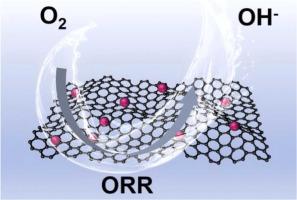金属Co与原子Co - n - c耦合作为可充电锌-空气电池的高效双功能氧电催化剂
IF 6.3
2区 材料科学
Q2 CHEMISTRY, PHYSICAL
引用次数: 0
摘要
开发高效、经济的双功能氧电催化剂是先进的可充电锌空气电池(ZABs)的关键。本文通过控制co配合物的热解合成了一种高活性的杂化催化剂,该催化剂由金属钴纳米颗粒偶联原子分散的Co-Nx-C位点嵌入在介孔氮掺杂碳基质(Co@NC-800)中组成。这种独特的结构诱导了电子调制,优化了氧中间体的吸附,导致氧还原反应(ORR,半波电位E1/2为0.91 V)和氧析反应(OER,过电位400 mV)具有优异的双功能活性,可逆氧势隙ΔE为0.72 V。此外,电化学结果和原位红外光谱(IR)共同证实,ORR通过更有效的4电子ORR过程形成水。当应用于ZABs时,Co@NC-800提供244.16 mW∙cm-2的峰值功率密度,卓越的速率能力,420小时内良好的循环稳定性,效率衰减最小,优于Pt/C+IrO2(1:1)基准。这项工作强调了协同电子相互作用在ORR/OER双功能和可充电ZABs的非贵金属杂化催化剂中的重要性。本文章由计算机程序翻译,如有差异,请以英文原文为准。

Coupling of metallic Co with atomic Co–N–C as efficient bifunctional oxygen electrocatalyst for rechargeable zinc-air battery
The development of efficient and cost-effective bifunctional oxygen electrocatalysts is critical for advanced rechargeable zinc–air batteries (ZABs). Here, a high-activity hybrid catalyst comprising metallic cobalt nanoparticles coupled with atomically dispersed Co-Nx-C sites embedded in a mesoporous nitrogen-doped carbon matrix (Co@NC-800) is synthesized via controlled pyrolysis of a Co–complex. This unique structure induces electronic modulation that optimizes the adsorption of oxygen intermediates, resulting in exceptional bifunctional activity for both the oxygen reduction reaction (ORR, half-wave potential E1/2 of 0.91 V) and oxygen evolution reaction (OER, overpotential of 400 mV), with a small reversible oxygen potential gap ΔE of 0.72 V. In addition, electrochemical results and in situ infrared spectroscopy (IR) jointly confirmed that ORR forms water through a more efficient 4-electron ORR process. When applied in ZABs, Co@NC-800 delivers a high peak power density of 244.16 mW∙cm-2, superior rate capability, and favorable cycling stability over 420 hours with minimal efficiency decay, outperforming Pt/C+IrO2 (1:1) benchmark. This work highlights the importance of synergistic electronic interactions in non-noble metal hybrid catalysts for ORR/OER bifunction and rechargeable ZABs.
求助全文
通过发布文献求助,成功后即可免费获取论文全文。
去求助
来源期刊

Journal of Alloys and Compounds
工程技术-材料科学:综合
CiteScore
11.10
自引率
14.50%
发文量
5146
审稿时长
67 days
期刊介绍:
The Journal of Alloys and Compounds is intended to serve as an international medium for the publication of work on solid materials comprising compounds as well as alloys. Its great strength lies in the diversity of discipline which it encompasses, drawing together results from materials science, solid-state chemistry and physics.
 求助内容:
求助内容: 应助结果提醒方式:
应助结果提醒方式:


